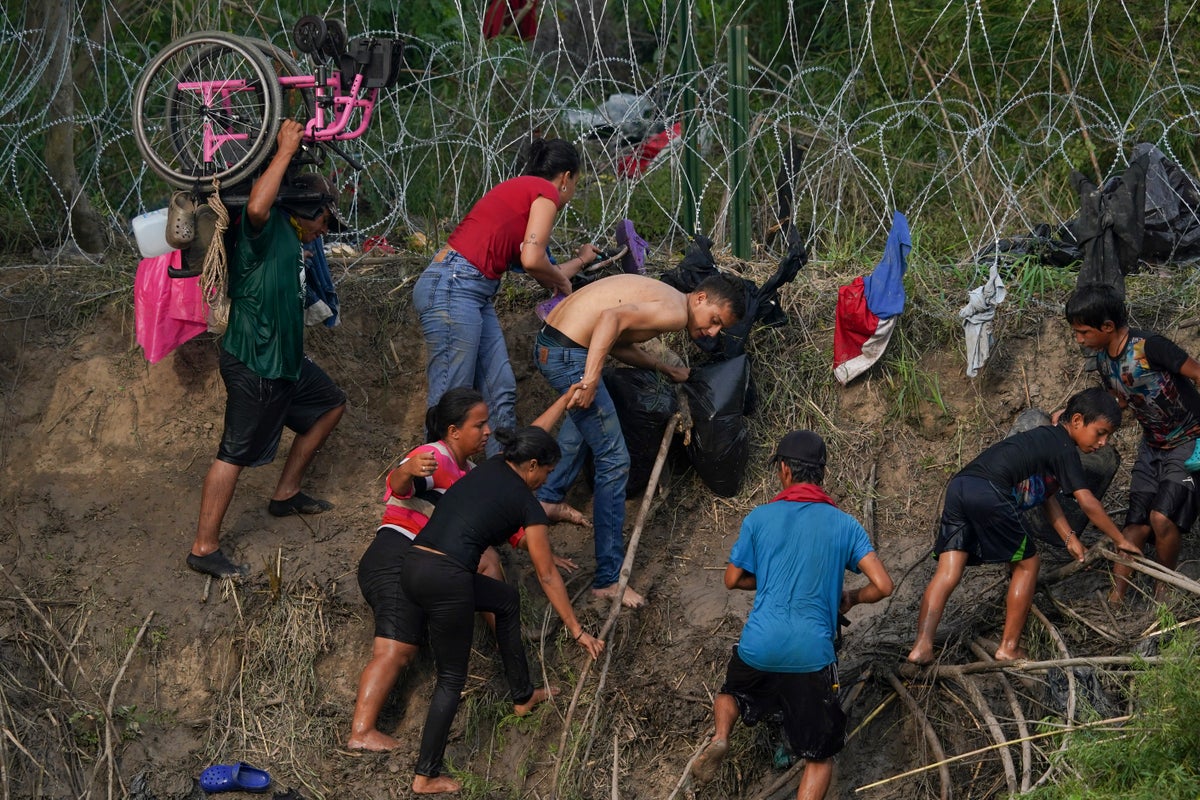
EDITORS/NEWS DIRECTORS:
Migrants who seek refuge in the United States are confronting a fundamental shift in border enforcement and opportunities for seeking asylum amid a surge in arrivals at the Southwest border.
Coronavirus restrictions on immigration are coming to an end this week after three years. Those rules were used nearly 3 million times to quickly expel migrants without greater penalties. Many migrants rushed to the border to cross before the restrictions known as Title 42 expired. Afterward, migrants caught crossing illegally will not be allowed to return for five years. They can face criminal prosecution if they do.
At the same time, cities including New York and Chicago with thriving immigrant communities are struggling to attend to a surge in new asylum seekers.
The Biden administration says it is creating new legal pathways for migrants to seek asylum in the U.S., Canada and Spain, including a plan to open 100 regional migration hubs across the Western Hemisphere. And it will eventually admit at least 100,000 from four Latin Americans countries seeking to be reunited family members that have become U.S. citizens or permanent residents.
But U.S. immigration authorities also will begin denying asylum to migrants who show up at the U.S.-Mexico border without first applying online or seeking protection in a country they passed through.
___
AP’S LATEST COVERAGE
Huge number of asylum seekers at US-Mexico border as COVID-19 restrictions end, new rules begin
US will let in at least 100,000 Latin Americans to reunite with families
Biden: US-Mexico border will be ‘chaotic for a while’
New York City sticking with migrant hotel plan despite pushback from suburbs
___
WHERE MIGRANTS GO
While migrants are released in border towns like San Diego; Yuma, Arizona; and El Paso, Eagle Pass and McAllen in Texas, they rarely spend more than a few nights there and are usually gone within hours after the Border Patrol turns them over to nongovernment groups for travel assistance. Migrant shelters in the El Paso area and southern New Mexico offer shuttles to major airports, where migrants get help from full-time travel assistants to board flights or cope with cancellations. Humanitarian groups in Yuma bus migrants to Phoenix Sky Harbor International Airport, and buses run constantly between Eagle Pass and the San Antonio International Airport.
Detailed breakdowns of where migrants go in the United States are not readily available, but they generally seek to join family and friends already settled in immigrant-heavy cities and states. An analysis of migrant releases in San Diego in 2019 showed Houston and Los Angeles were the top two destinations but included some surprises. Dumas, a town of 15,000 people in the Texas Panhandle that has a large meatpacking plant, ranked high, as did Huntsville and Gadsden in Alabama and Chattanooga, Tennessee.
___
QUESTIONS FOR IMMIGRATION ATTORNEYS
Contact local immigration attorneys and ask how many migrants released at the border are arriving in your area and where they’re from. Ask to speak to their clients. Why did they come to the United States? If you don’t know any immigration attorneys, contact the American Immigration Lawyers Association for recommendations or check if a nearby university has an immigration law clinic that can help.
___
QUESTIONS FOR STATE AND LOCAL OFFICIALS
— Have states, counties and cities witnessed an increase in migrant arrivals from the border and, if so, since when? How have migrants fared in terms of housing, food, education and health care? Has it affected government budgets or strained nongovernment organizations that assist homeless and others?
— Are more migrants expected and what, if anything, is being done to prepare?
___
QUESTIONS ABOUT PUBLIC OPINION
To what extent has asylum generally resonated? Are prominent civic and faith leaders speaking out the end of Title 42 restrictions and what comes next? Why or why not?
___
QUESTIONS FOR FEDERAL OFFICIALS
— If your area has an ICE office, how is it being affected by migrants on parole? Are there lines outside of people checking in?
— If your area has an immigration court, are there cases involving migrants who recently crossed the border? Can you describe them?
___
RESOURCES
— List of immigration courts from the Executive Office for Immigration Review: https://www.justice.gov/eoir/immigration-court-administrative-control-list
— ICE field offices, searchable by state: https://www.ice.gov/contact/field-offices
___
PUBLISHABLE CONTEXT
A new asylum rule announced Wednesday is part of measures meant to crack down on illegal border crossings while creating new legal pathways.
The rule takes the place of Title 42 restrictions that were put in place under then-President Donald Trump in March 2020, preventing hundreds of thousands of migrants from seeking asylum in the U.S. in recent years.
The new rule will begin denying asylum to migrants who arrive at the U.S.-Mexico border without first applying online or seeking protection in a country they passed through. It marks a fundamental shift in U.S. immigration policy. Migrants caught crossing illegally will not be allowed to return for five years. They can face criminal prosecution if they do. U.S. officials says they've taken steps to increase deportation flights.
But U.S. officials also hope to cut off smuggling and create new ways for migrants to leave home and find refuge from political and economic turmoil. There’s a plan to open 100 regional migration hubs across the Western Hemisphere to handle asylum requests and help qualified migrants seek refuge in the U.S., Canada or Spain. The U.S. is granting humanitarian parole to 30,000 people a month to enter the country from four countries.
Conservative-leaning states have argued that lifting Title 42 will lead to a surge of migrants into their states and take a toll on government services like health care or law enforcement. They also charge that the federal government has not planned to deal with an increase in migrants.
Human rights groups say they plan to quickly challenge new restrictions in court and warn that migrants of various nationalities will be stranded in northern Mexico. They see serious problems with a rule that presumes that migrants can get protection from another country or find an appointment online to seek asylum in the U.S.







